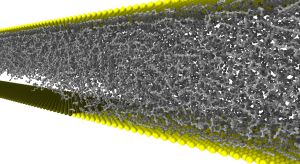Researchers have discovered a so-far unknown mechanism for the formation of cavitation bubbles by the means of model calculation. In the Science Advances journal, they describe how oil-repellent and oil-attracting surfaces influence lubricant flow. Depending on the viscosity of the oil, a vapor bubble forms in the transition area between oleophobic and oleophilic domains. This so-called cavitation is known to damage material of e.g. ship propellers or pumps. However, in lubricated contacts it can have a positive effect, as it may help separating the surfaces and thus preventing damage. DOI: 10.1126/sciadv.1501585
The group of computational tribologists at KIT was interested in the influence that chemically heterogeneous surfaces have on the flow of a lubricant. They analyzed in particular nanometer-sized lubrication gaps, a critical scenario close to boundary friction, i.e. shortly before the surfaces are in direct contact. For this purpose, they created a mathematical model in which they varied viscosity of the lubricant and the chemical properties of the surfaces. “We were very surprised to find cavitation in the transition area of the surfaces, i.e. at the boundary between oil-attracting and oil-repellent surface spots,” Dr. Lars Pastewka and Professor Peter Gumbsch of KIT’s Institute for Applied Materials report.
Due to its destructive force, cavitation is a well-known and feared phenomenon. “Current cavitation models assume that geometry causes cavitation, such as high flow rates in constrictions in pumps or near a ship’s propeller,” Pastewka explains. Bernoulli’s law states that the static pressure of a fluid decreases with increasing flow rate. If the static pressure drops below the vapor pressure of the fluid, bubbles form. If pressure increases again, e.g. if the fluid flow rate decreases after having passed a constriction in a pump, the vapor condenses and the bubbles implode. This leads to spikes in pressure and temperature that can erode even hardened steel.
“This sudden implosion of vapor bubbles, however, does not occur in most lubricated tribosystems,” says Dr. Daniele Savio, now researching at the Fraunhofer Institute for Mechanics of Materials in Freiburg. “As the fluid gap between two contacting surfaces is usually very narrow, the cavitation bubbles cannot grow and remain stable. Hence, they have no destructive effect, and may even serve as a buffer that reduces wear and friction of the surfaces. It is therefore important to generate this positive effect in a controlled manner”.
The simulation model of Savio and his colleagues confirms that chemically patterned surfaces may lead to cavitation bubbles. Their publication in Science Advances started from the question of whether cavitation is the rule or an exception in situations where a lubricant flows between two surfaces. “Real surfaces are never truly homogeneous, i.e. only oil-attracting or oil-repellent,” Savio points out. “The effect we observed may therefore be encountered wherever surface properties vary in lubricated mechanisms, such as in engines or pumps.”
So far, cavitation has been considered a geometric effect resulting from shear forces, flow rate, and pressure differences exclusively. “It is a completely new finding that fluids cavitate when local changes in surface chemistry occur,” Pastewka emphasizes. The researchers are convinced that interactions between surface and lubricant can be improved considerably through specific adjustments of surface chemistry. In the model simulations, surface separation was for instance increased by 10%.
“This improvement indicates that hydrodynamic lift and the load carrying capacity in bearings or other lubricated components can be increased,” Savio adds. In any case, the scientists agree that surface chemistry has to be re-evaluated as a design element in mechanical engineering.
In close partnership with society, KIT develops solutions for urgent challenges – from climate change, energy transition and sustainable use of natural resources to artificial intelligence, sovereignty and an aging population. As The University in the Helmholtz Association, KIT unites scientific excellence from insight to application-driven research under one roof – and is thus in a unique position to drive this transformation. As a University of Excellence, KIT offers its more than 10,000 employees and 22,800 students outstanding opportunities to shape a sustainable and resilient future. KIT – Science for Impact.

